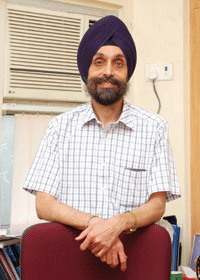Sixty years after independence, the 4,000 members of the elite IAS continue to exercise power out of all proportion to their number, as they preside over the country’s massive bureaucracy
The Indian Civil Service, the elite governing corps which was the ‘steel frame’ of the British Raj for almost a century (1857-1957), transformed into the Indian Administrative Service (IAS) after independence on August 15, 1947. Sixty years later the 4,000 members of the ‘twice-born’ IAS continue to exercise power out of all proportion to their number, as they preside over the country’s massive 18-million strong (Centre plus states) bureaucracy.
Despite charges of corruption, politicisation, red tapism and falling standards, for millions of youth across the country the appeal of the power, prestige and social status associated with the IAS has not waned. In May this year 200,000 wrote the Civil Services Examination conducted by the Union Public Services Commission (UPSC) for entry into the IAS, IFS, IPS and the Central Services Group A and B (Indian Revenue Service, Indian Economic Service etc). The Civil Services Examination is held in two parts, the first being a preliminary objective questions-type which is for elimination and shortlisting candidates for the main exam. The notification for the exam citing the venues is published in newspapers every December, and the exam is held every summer.
The second or main exam is held in the month of November, with those who have cleared the preliminary exam entitled to write the nine essay papers consisting of Indian language, English, general essay, general studies (two papers) and four papers in optional subjects.
Candidates who obtain minimum qualifying marks in this exam are summoned for interview by a UPSC board panel, with the objective of assessing his/her suitability for a career in public service. The personal interview is designed to judge the intellectual qualities, social traits and interest in current affairs of candidates. Marks obtained by candidates in the main examination (written as well as interview) determine their final ranking. The selection process is spread over 12 months. Of the over 200,000 who write the preliminary exam, only 400-500 are selected annually. Of those selected the toppers have the option to choose their service between the IAS, IPS, IFS etc.
Graduates with a degree from an Indian university or possessing an equivalent qualification, between 21 and 30 years of age, and citizens of India, are eligible to write the Civil Services Exam, with each candidate allowed a maximum of four attempts to clear it.
Once selected, those inducted into the civil service have to undergo a year’s training at the Lal Bahadur Shastri National Academy of Administration, Mussoorie. After completing this training stint, IAS recruits are sent to districts in their allotted states on one year’s probation as supernumerary assistant collectors. Subsequently they move upwards through a series of time-bound promotions until they reach the rank of joint secretary at the Centre, after which there’s an element of selectivity in promotions. Most IAS officers, however, rise to the rank of chief secretary of a state government.
Although nowhere near the private sector, IAS pay scales have recently been hiked by the Sixth Pay Commission, under which basic salaries rise from Rs.21,000 per month at the entry level to Rs.80,000 at the highest level. Moreover IAS officers are also entitled to dearness allowance, heavily subsidised residential accommodation and liberal perks.
 “One of the great attractions and challenges of the IAS is that you have to handle a variety of jobs, enabling one to acquire wide experience. In the formative years, a young IAS officer has to focus on policy implementation and team building. Later, in the higher reaches of the Central and state government, one’s accumulated exper-ience is brought to bear on policy formulation,” says Urvinder Madan, IAS, currently project manager of the Mumbai Transformation Support Unit (MTSU), promoted in 2005 by the World Bank, Cities Alliance, USAID, All India Institute of Local Self-Government and government of Maharashtra, to transform Mumbai into a world-class city.
“One of the great attractions and challenges of the IAS is that you have to handle a variety of jobs, enabling one to acquire wide experience. In the formative years, a young IAS officer has to focus on policy implementation and team building. Later, in the higher reaches of the Central and state government, one’s accumulated exper-ience is brought to bear on policy formulation,” says Urvinder Madan, IAS, currently project manager of the Mumbai Transformation Support Unit (MTSU), promoted in 2005 by the World Bank, Cities Alliance, USAID, All India Institute of Local Self-Government and government of Maharashtra, to transform Mumbai into a world-class city.
To this unique and challenging assignment which is now in its second phase, Madan brings rich and varied 25 years’ experience as an IAS officer. Inducted into the IAS after acquiring commerce and law degrees from the Punjabi University, Patiala, Madan traversed the corridors of power as assistant collector, Aurangabad (1985-87); additional collector Sangli; municipal commissioner, Kalyan Municipal Corporation; collector of Nanded and was deputed to the Dept. of Atomic Energy for four years. After serving as director of the Mumbai urban transport project in MMRDA (Mumbai Metropolitan Region Development Authority), vice-president and CEO of MHADA, and chief electoral officer of Maharashtra for three years, since October 2007 he has been in his current assignment with MTSU.
“The breadth of experience that one acquires in the IAS cannot be matched by any other career. Moreover an IAS officer has the opportunity and power to change the lives of millions of people and help realise the dreams of the leaders of India’s freedom movement and founding fathers of the Constitution. And contrary to popular opinion, this elite cadre has made great contributions to the unity and progress of independent India,” says Madan.
Indra Gidwani (Mumbai)